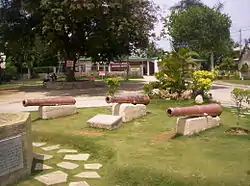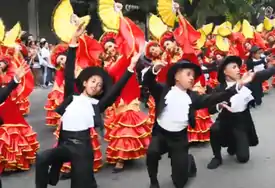Argao
Argao, officially the Municipality of Argao (Cebuano: Lungsod sa Argao; Tagalog: Bayan ng Argao), is a 1st class municipality in the province of Cebu, Philippines. According to the 2015 census, it has a population of 72,366 people. [3]
Argao | |
|---|---|
| Municipality of Argao | |
 Old cannons of Argao | |
 Map of Cebu with Argao highlighted | |
OpenStreetMap 
| |
.svg.png.webp) Argao Location within the Philippines | |
| Coordinates: 9°53′N 123°36′E | |
| Country | Philippines |
| Region | Central Visayas (Region VII) |
| Province | Cebu |
| District | 2nd District |
| Founded | 1608 [1] |
| Barangays | 45 (see Barangays) |
| Government | |
| • Type | Sangguniang Bayan |
| • Mayor | Allan M. Sesaldo |
| • Vice Mayor | Jessa Mae S. Flores-Mier |
| • Representative | Wilfredo S. Caminero |
| • Electorate | 49,794 voters (2019) |
| Area | |
| • Total | 191.50 km2 (73.94 sq mi) |
| Elevation | 43 m (141 ft) |
| Population | |
| • Total | 72,366 |
| • Density | 380/km2 (980/sq mi) |
| • Households | 16,504 |
| Economy | |
| • Income class | 1st municipal income class |
| • Poverty incidence | 25.25% (2015)[4] |
| • Revenue | ₱160,648,091.03 (2016) |
| Time zone | UTC+8 (PST) |
| ZIP code | 6021 |
| PSGC | |
| IDD : area code | +63 (0)32 |
| Climate type | tropical rainforest climate |
| Native languages | Cebuano Tagalog |
| Patron saint | Michael the Archangel |
Geography
The municipality of Argao is located in the southeast of the province of Cebu, 67 kilometres (42 mi) from Cebu City.
Argao is bordered to the north by the municipality of Sibonga, to the west are the municipalities of Ronda, Alcantara and Moalboal, to the east is the Cebu Strait, and to the south is the municipality of Dalaguete.
Barangays
Argao comprises 45 barangays:
| PSGC | Barangay | Population | ±% p.a. | |||
|---|---|---|---|---|---|---|
| 2015 [3] | 2010 [5] | |||||
| 072205001 | Alambijud | 2.1% | 1,542 | 1,514 | 0.35% | |
| 072205002 | Anajao | 1.0% | 742 | 907 | −3.75% | |
| 072205003 | Apo | 1.0% | 692 | 664 | 0.79% | |
| 072205004 | Balaas | 1.1% | 789 | 985 | −4.14% | |
| 072205005 | Balisong | 2.9% | 2,105 | 1,944 | 1.53% | |
| 072205006 | Binlod | 4.7% | 3,386 | 3,343 | 0.24% | |
| 072205007 | Bogo | 4.9% | 3,557 | 3,505 | 0.28% | |
| 072205009 | Bug‑ot | 1.2% | 884 | 837 | 1.05% | |
| 072205010 | Bulasa | 5.0% | 3,648 | 3,523 | 0.67% | |
| 072205008 | Butong | 1.3% | 966 | 924 | 0.85% | |
| 072205012 | Calagasan | 1.5% | 1,062 | 875 | 3.76% | |
| 072205013 | Canbantug | 1.2% | 844 | 843 | 0.02% | |
| 072205014 | Canbanua | 3.5% | 2,507 | 2,179 | 2.71% | |
| 072205015 | Cansuje | 3.2% | 2,327 | 2,206 | 1.02% | |
| 072205016 | Capio‑an | 1.5% | 1,098 | 1,192 | −1.55% | |
| 072205017 | Casay | 1.2% | 883 | 788 | 2.19% | |
| 072205018 | Catang | 0.8% | 614 | 651 | −1.11% | |
| 072205019 | Colawin | 1.3% | 961 | 943 | 0.36% | |
| 072205020 | Conalum | 0.8% | 585 | 615 | −0.95% | |
| 072205021 | Guiwanon | 2.6% | 1,856 | 1,726 | 1.39% | |
| 072205022 | Gutlang | 1.2% | 856 | 770 | 2.04% | |
| 072205023 | Jampang | 3.5% | 2,499 | 2,217 | 2.31% | |
| 072205024 | Jomgao | 1.5% | 1,111 | 1,102 | 0.15% | |
| 072205025 | Lamacan | 3.7% | 2,654 | 2,256 | 3.14% | |
| 072205026 | Langtad | 4.3% | 3,145 | 2,887 | 1.64% | |
| 072205027 | Langub | 1.0% | 745 | 804 | −1.44% | |
| 072205028 | Lapay | 0.9% | 683 | 677 | 0.17% | |
| 072205029 | Lengigon | 1.5% | 1,080 | 989 | 1.69% | |
| 072205030 | Linut‑od | 1.4% | 1,026 | 1,024 | 0.04% | |
| 072205031 | Mabasa | 1.8% | 1,267 | 1,281 | −0.21% | |
| 072205032 | Mandilikit | 0.9% | 664 | 645 | 0.55% | |
| 072205033 | Mompeller | 1.2% | 857 | 753 | 2.49% | |
| 072205034 | Panadtaran | 0.8% | 586 | 524 | 2.15% | |
| 072205035 | Poblacion | 7.5% | 5,454 | 5,570 | −0.40% | |
| 072205036 | Sua | 1.2% | 899 | 755 | 3.38% | |
| 072205037 | Sumaguan | 1.3% | 964 | 883 | 1.69% | |
| 072205038 | Tabayag | 1.2% | 894 | 999 | −2.09% | |
| 072205039 | Talaga | 4.9% | 3,510 | 3,485 | 0.14% | |
| 072205040 | Talaytay | 2.3% | 1,686 | 1,438 | 3.08% | |
| 072205041 | Talo‑ot | 5.5% | 3,990 | 3,683 | 1.54% | |
| 072205042 | Tiguib | 1.2% | 866 | 1,202 | −6.05% | |
| 072205043 | Tulang | 1.2% | 856 | 869 | −0.29% | |
| 072205044 | Tulic | 3.9% | 2,805 | 2,494 | 2.26% | |
| 072205045 | Ubaub | 1.5% | 1,083 | 968 | 2.16% | |
| 072205046 | Usmad | 1.6% | 1,138 | 1,064 | 1.29% | |
| Total | 72,366 | 69,503 | 0.77% | |||
Climate
| Climate data for Argao, Cebu | |||||||||||||
|---|---|---|---|---|---|---|---|---|---|---|---|---|---|
| Month | Jan | Feb | Mar | Apr | May | Jun | Jul | Aug | Sep | Oct | Nov | Dec | Year |
| Average high °C (°F) | 29 (84) |
30 (86) |
31 (88) |
32 (90) |
31 (88) |
30 (86) |
30 (86) |
30 (86) |
30 (86) |
29 (84) |
29 (84) |
29 (84) |
30 (86) |
| Average low °C (°F) | 23 (73) |
22 (72) |
23 (73) |
24 (75) |
25 (77) |
25 (77) |
24 (75) |
24 (75) |
24 (75) |
24 (75) |
24 (75) |
23 (73) |
24 (75) |
| Average precipitation mm (inches) | 42 (1.7) |
34 (1.3) |
40 (1.6) |
61 (2.4) |
124 (4.9) |
188 (7.4) |
190 (7.5) |
191 (7.5) |
189 (7.4) |
186 (7.3) |
124 (4.9) |
73 (2.9) |
1,442 (56.8) |
| Average rainy days | 10.0 | 8.5 | 9.5 | 12.8 | 22.3 | 26.8 | 28.4 | 27.9 | 27.3 | 27.6 | 20.5 | 13.1 | 234.7 |
| Source: Meteoblue (Use with caution: this is modeled/calculated data, not measured locally.)[6] | |||||||||||||
Demographics
|
| ||||||||||||||||||||||||||||||||||||||||||
| Source: Philippine Statistics Authority [3] [5] [7] | |||||||||||||||||||||||||||||||||||||||||||
Tourism
The economy of the town of Argao heavily revolves around farming, baking, and tourism. Argao is renowned in Cebu as the "Torta Capital of the Province" because of its local delicacy, the Torta, a Cebuano tart that is inspired from the Spanish tart, but differs in its recipe by using tubâ or palm wine as the rising agent instead of the usual yeast. There are three Cebuano baking towns, the others are Liloan and Santander.
The La Torta Festival, which replaced the Pitlagong Festival in 2011, is the municipality's local food festival in honor of St Michael the Archangel, the patron saint of Argao. La Torta Festival happens every 28–29 September to celebrate Argao's Tart Economy and the torta as an Argaoanon delicacy, as well as cultural heritage from the Spanish period, which includes the tradition of making the torta.
Argao is also a producer of Cebuano tsokolate (chocolate). Much of the cocoa production originates from Argao. The raw cacao, once harvested, is molded, while melted, into disk-shaped tablets called tablea. These are often used in sikwate, a Cebuano version of hot chocolate. The production of chocolate in Argao is said to have been pre-colonial. Maria Cacao, a goddess of the Lantoy Mountain, is said to have been the giver of the cacao tree to the natives of Argao, according to legend. It is said that she and her husband Mangao reside in a cave in that area, surrounded by cacao trees.
Argao is, additionally, a producer of vinegar in the province. When the tubâ ferments or when it is aged too long, it becomes sour. It eventually turns into vinegar which is used as sauce or as component for a sauce in main courses. The palm vinegar is referred to as sukang tubâ. It is often accompanied with spices such as garlic and chili peppers and usually comes by the bottle.
 St Michael Parish Church
St Michael Parish Church Rizal statue at Municipal plaza
Rizal statue at Municipal plaza The La Torta Festival
The La Torta Festival Pres. Diosdado Macapagal Sports & Cultural Center
Pres. Diosdado Macapagal Sports & Cultural Center Argao Public Market
Argao Public Market
References
- Encyclopædia Britannica (1911). "Argao". Encyclopædia Britannica. 2 (11th ed.). p. 457.CS1 maint: ref=harv (link)
- "Province: Cebu". PSGC Interactive. Quezon City, Philippines: Philippine Statistics Authority. Retrieved 12 Nov 2016.
- Census of Population (2015). "Region VII (Central Visayas)". Total Population by Province, City, Municipality and Barangay. PSA. Retrieved 20 Jun 2016.
- "PSA releases the 2015 Municipal and City Level Poverty Estimates". Quezon City, Philippines. Retrieved 12 Oct 2019.
- Census of Population and Housing (2010). "Region VII (Central Visayas)". Total Population by Province, City, Municipality and Barangay. NSO. Retrieved 29 Jun 2016.
- "Argao: Average Temperatures and Rainfall". Meteoblue. Retrieved 9 May 2020.
- Censuses of Population (1903–2007). "Region VII (Central Visayas)". Table 1. Population Enumerated in Various Censuses by Province/Highly Urbanized City: 1903 to 2007. NSO.
External links
| Wikisource has the text of the 1911 Encyclopædia Britannica article Argao. |
 Media related to Argao, Cebu at Wikimedia Commons
Media related to Argao, Cebu at Wikimedia Commons- Argao Profile at PhilAtlas.com